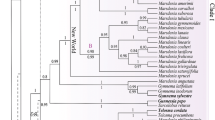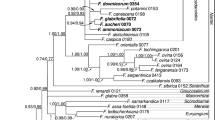Summary
A phylogenetic classification of tribe Poranthereae Grüning (Phyllanthaceae Martynov) is presented, based on molecular studies using DNA sequence data of nuclear ITS and plastid matK regions in conjunction with morphological characters. The tribe contains eight genera, four subgenera and 111 species. Circumscription of the genera differs considerably from previous systems. Only Actephila Blume remains unchanged. Andrachne sensu lato is divided into five genera: Andrachne L., Leptopus Decne., Notoleptopus Voronts. & Petra Hoffm., Phyllanthopsis (Scheele) Voronts. & Petra Hoffm., Pseudophyllanthus (Müll. Arg.) Voronts. & Petra Hoffm.; two further species are transferred to Meineckia Baill. subgenus Petaliferae Voronts. & Petra Hoffm. Archileptopus P. T. Li is included in Leptopus; Oreoporanthera (Grüning) Hutch. is included in Poranthera Rudge; Zimmermannia Pax and Zimmermanniopsis Radcl.-Sm. are included in Meineckia subgenus Meineckia. The genus Notoleptopus and Meineckia subgenus Petaliferae are newly described; Phyllanthopsis and Pseudophyllanthus are raised to generic level; Andrachne subgen. Phyllanthidea (Didr.) Voronts. & Petra Hoffm. is raised to subgeneric level. Six new combinations and a nomen novum are made at species level: Leptopus fangdingianus (P. T. Li) Voronts. & Petra Hoffm., Phyllanthopsis phyllanthoides Voronts. & Petra Hoffm., P. arida (Warnock & M. C. Johnst.) Voronts. & Petra Hoffm., Pseudophyllanthus ovalis (E. Mey. ex Sond.) Voronts. & Petra Hoffm., Notoleptopus decaisnei (Benth.) Voronts. & Petra Hoffm., Meineckia cerebroides (Petra Hoffm.) Voronts. & Petra Hoffm. and M. gracilipes (Petra Hoffm.) Voronts. & Petra Hoffm. Morphology and geographical distribution is discussed with special reference to petals, disc morphology and seed.






Similar content being viewed by others
References
Allan, H. H. (1961). Euphorbiaceae. In: Flora of New Zealand 1: 345 – 346. R. E. Owen, Wellington.
Baillon, H. E. (1858). Étude générale du groupe des Euphorbiacées. Victor Masson, Paris.
Bentham, G. (1873). Andrachne. In: Flora australiensis 6: 87 – 88. Lovell Reeve & Co., London.
Blume, C. L. (1826). Actephila. In: Bijdragen tot de Flora van Nederlandsch Indië: 581. Lands Drukkerij, Batavia.
Brunel, J. F. (1987). Sur le genre Phyllanthus L. et quelques genres voisins de la Tribu des Phyllantheae Dumort. (Euphorbiaceae, Phyllantheae) en Afrique intertropicale et à Madagascar. Thèse doctorale, Université Louis Pasteur, Strasbourg.
Dalzell, N. A. (1851). Contributions to the Botany of Western India. Hooker’s J. Bot. Kew Gard. Misc. 3: 225 – 233.
Decaisne, J. (1844). Leptopus. In: V. Jacquemont & J. Cambessedes, Voyage dans l’Inde 4: Plantae rariores, quas in India orientali collegit, 155 – 156, tab. 156. Firmin Didot Freres, Paris.
Didrichsen, F. (1857). Plantas nonnullas [not nonnullus as in TL2] musei Universitatis Hauniensis descripsit. Manipulus tertius. Vidensk. Meddel. Dansk Naturhist. Foren. Kjobenhavn 1857: 123 – 151.
El-Ghazaly, G. & Raj, B. (1986). A contribution to the pollen morphology of Andrachne (Euphorbiaceae). Pollen & Spores 28: 297 – 310.
Endlicher, S. F. L. (1840). Lithoxylon. In: Genera plantarum secundum ordines naturales disposita 2: 1122. Fr. Beck, Vienna.
Forsskål, P. (1775). Eraclissa hexagyna. In: Flora aegyptiaco-arabica: 208. Möller, Copenhagen.
Forster, P. I. (2005). A taxonomic revision of Actephila Blume (Euphorbiaceae/ Phyllanthaceae) in Australia. Austrobaileya 7: 57 – 98.
Gagnepain, F. (1924 publ. 1925). Quelques genres nouveaux d’Euphorbiacées. Bull. Soc. Bot. France 71: 864 – 879.
Gamble, J. S. (1925). Neopeltandra. In: Flora of the presidency of Madras 2: 1285 – 1286. West Newman & Co., Adlard & Son, London.
Govaerts, R., Frodin, D. G. & Radcliffe-Smith, A. (2000). World checklist and bibliography of Euphorbiaceae (with Pandaceae), vols. 1 – 4. Royal Botanic Gardens, Kew.
Grüning, G. (1913). Euphorbiaceae-Porantheroideae et Ricinocarpoideae. In: A. Engler (ed.), Das Pflanzenreich, Heft 58. Wilhelm Engelmann, Berlin.
Halford, D. A. & Henderson, R. J. F. (2005). Studies in Euphorbiaceae s.lat. 6. A revision of the genus Poranthera Rudge (Antidesmeae, Porantherinae) in Australia. Austrobaileya 7: 1 – 27.
Hasskarl, J. C. (1844). Savia. In: Catalogus plantarum in horto botanico bogoriensi cultarum alter: 243. Batavia.
Hoffmann, P. (1994). A contribution to the systematics of Andrachne sect. Phyllanthopsis and sect. Pseudophyllanthus compared with Savia s.l. (Euphorbiaceae) with special reference to floral morphology. Bot. Jahrb. Syst. 116: 321 – 331.
____ (2000). Revision of Andrachne sect. Pseudophyllanthus (Euphorbiaceae), with the description of two new species from Madagascar. Adansonia, sér. 3, 22: 123 – 133.
____ (2007). Revision of Heterosavia (Urb.) Petra Hoffm., stat. nov., with notes on Gonatogyne Müll. Arg. and Savia Willd. (Phyllanthaceae). Brittonia (in press).
____, Kathriarachchi, H. & Wurdack, K. J. (2006). A phylogenetic classification of Phyllanthaceae (Malpighiales; Euphorbiaceae sensu lato). Kew Bull. 61: 37 – 53.
Hurusawa, I. (1954). Eine nochmalige Durchsicht des herkömmlichen Systems der Euphorbiaceen in weiteren Sinne. J. Fac. Sci. Univ. Tokyo, Sect. 3, Bot. 6: 209 – 341.
Hutchinson, J. (1969). Tribalism in the family Euphorbiaceae. Amer. J. Bot. 56: 738 – 758.
Li, P. T. (1991). A new genus of Euphorbiaceae and some new nomenclatural combination of the Asclepiadaceous plants. J. S. China Agric. Univ. 12(3): 38 – 42.
Linné, C. (1753). Andrachne. In: Species plantarum 2: 1014. Impensis Laurentii Salvii, Stockholm.
Kathriarachchi, H., Hoffmann, P., Samuel, R., Wurdack, K. J. & Chase, M. W. (2005). Molecular phylogenetics of Phyllanthaceae inferred from five genes (plastid atpB, matK, 3′ndhF, rbcL, nuclear PHYC). Molec. Phylogen. Evol. 36: 112 – 134.
Köhler, E. (1965). Die Pollenmorphologie der biovulaten Euphorbiaceae und ihre Bedeutung für die Taxonomie. Grana Palynol. 6: 26 – 120.
McNeill, J., Barrie, F. R., Burdet, H. M., Demoulin, V., Hawksworth, D. L., Marhold, K., Nicolson, D. H., Prado, J., Silva, P. C., Skog, J. E., Wiersema, J. H. & Turland, N. J. (2006). International Code of Botanical Nomenclature. A. R. G. Gantner Verlag, Ruggell, Liechtenstein.
Miquel, F. A. W. (1859) Actephila. In: Flora van Nederlandsch Indië 1(2): 356. C. G. van der Post, Amsterdam; C. van der Post Jr., Utrecht; Fried. Fleischer, Leipzig.
Moench, C. (1802). Telephioides. In: Supplementum ad methodum plantas a staminum situ describendi: 310. Marburg, Germany.
Müller, J. (1863). Euphorbiaceae. Vorläufige Mittheilungen aus dem für De Candolle’s Prodromus bestimmten Manuscript über diese Familie. Linnaea 32: 1 – 126.
____ (1864). Euphorbiaceae novae a cl. Dr. Welwitsch in Africa Aequinoctiali Occidentali lectae. J. Bot. 2: 327 – 339.
____ (1865). Euphorbiaceae. Vorläufige Mittheilungen aus dem für De Candolle’s Prodromus bestimmten Manuscript über diese Familie. Linnaea 34: 1 – 224.
____ (1866). Euphorbiaceae. In: A. P. De Candolle (ed.), Prodromus systematis naturalis regni vegetabilis 15(2): 189 – 1286. Victor Masson, Paris.
Necker, N. J. (1790). Arachne. In: Elementa Botanica 2: 348 – 349. Apud Societatem Typographicam, Neuwied, Germany.
Nees von Esenbeck, C. G. (1830). Beitrag zur Kenntniss der Familien der Restiaceen in Rücksicht auf Gattungen und Arten. Linnaea 5: 627 – 666.
Nuttall, T. (1835). Collections towards a flora of the Territory of Arkansas. Trans. Amer. Philos. Soc., n.s. 5: 139 – 203.
Pax, F. (1890). Euphorbiaceae. In: A. Engler & K. Prantl (eds.), Die natürlichen Pflanzenfamilien, 1st ed., 3(5). Wilhelm Engelmann, Leipzig.
____ (1910). Euphorbiaceae africanae. XI. Bot. Jahrb. Syst. 45: 234 – 241.
Pojarkova, A. I. (1960). Incrementa ad monographiam generum Andrachne L. et Leptopus Decne. Bot. Mater. Gerb. Bot. Inst. Komarova Akad. Nauk S.S.S.R. 20: 251 – 274.
Punt, W. (1962). Pollen morphology of the Euphorbiaceae with special reference to taxonomy. Wentia 7: 1 – 116.
Radcliffe-Smith, A. (1997). Notes on African and Madagascan Euphorbiaceae. Kew Bull. 52: 171 – 176.
____ (2001). Genera Euphorbiacearum. Royal Botanic Gardens, Kew.
____ & Harley, M. M. (1990). Notes on African Euphorbiaceae XXI: Aerisilvaea & Zimmermanniopsis, two new phyllanthoid genera for the flora of Tanzania. Kew Bull. 45: 147 – 156.
Rudge, E. (1811). A description of several species of plants from New Holland. Trans. Linn. Soc. London 10: 283 – 303.
Samuel, R., Kathriarachchi, H., Hoffmann, P., Barfuss, M. H. J., Wurdack, K. J., Davis, C. C. & Chase, M. W. (2005). Molecular phylogenetics of Phyllanthaceae: Evidence from plastid matK and nuclear PHYC sequences. Amer. J. Bot. 92: 132 – 141.
Scheele, A. (1853). Beiträge zur Kenntniss der Euphorbiaceen. Linnaea 25: 580 – 588.
Sonder, O. W. (1850). Beiträge zur Flora von Südafrica. Linnaea 23: 1 – 138.
Stuppy, W. (1996). Systematische Morphologie und Anatomie der Samen der biovulaten Euphorbiaceen. Ph.D. dissertation, Fachbereich Biologie, Universität Kaiserslautern, Kaiserslautern.
Verdcourt, B. (1954). Notes from the East African Herbarium: II. Kew Bull. 9: 35 – 42.
Vorontsova, M. S., Hoffmann, P., Maurin, O. & Chase, M. W. (2007). Molecular phylogenetics of tribe Poranthereae (Phyllanthaceae; Euphorbiaceae sensu lato). Amer. J. Bot. 94: 2026 – 2040.
Warnock, B. H. & Johnston, M. C. (1960). The genus Savia (Euphorbiaceae) in Extreme Western Texas. Southw. Naturalist 5: 1 – 6.
Webster, G. L. (1965). A revision of the genus Meineckia (Euphorbiaceae). Acta Bot. Neerl. 14: 323 – 365.
____ (1967). The genera of Euphorbiaceae in the Southeastern United States. J. Arnold Arbor. 48: 303 – 430.
____ (1970). A revision of Phyllanthus (Euphorbiaceae) in the continental United States. Brittonia 22: 44 – 76.
____ (1994). Synopsis of the genera and suprageneric taxa of Euphorbiaceae. Ann. Missouri Bot. Gard. 81: 33 – 144.
Wheeler, L. C. (1939). A miscellany of New World Euphorbiaceae, – II. Contr. Gray Herb. 127: 48 – 78.
Wight, R. (1852). Peltandra. In: Icones plantarum Indiae orientalis 5: 24 – 25, tab. 1891 – 1892. J. B. Pharoah, Madras.
Wurdack, K. J., Hoffmann, P., Samuel, R., de Bruijn, A., van der Bank, M. & Chase, M. W. (2004). Molecular phylogenetic analysis of Phyllanthaceae (Phyllanthoideae pro parte, Euphorbiaceae sensu lato) using plastid rbcL DNA sequences. Amer. J. Bot. 91: 1882 – 1900.
____, ____ & Chase, M. W. (2005). Molecular phylogenetic analysis of uniovulate Euphorbiaceae (Euphorbiaceae sensu stricto) using plastid rbcL and trnL-F DNA sequences. Amer. J. Bot. 92: 1397 – 1420.
Acknowledgements
The authors are grateful to Gill Challen (K) for curatorial assistance, Lucy T. Smith (K) for the artwork, Rosemary Davies (K) for help with bibliography and nomenclature, Katherine Challis and Christine Barker (both K) for advice on nomenclature and Melanie Thomas (K) for help with Latin diagnoses.
Author information
Authors and Affiliations
Corresponding author
Rights and permissions
About this article
Cite this article
Vorontsova, M.S., Hoffmann, P. A phylogenetic classification of tribe Poranthereae (Phyllanthaceae, Euphorbiaceae sensu lato). Kew Bull 63, 41–59 (2008). https://doi.org/10.1007/s12225-007-9012-8
Received:
Revised:
Accepted:
Published:
Issue Date:
DOI: https://doi.org/10.1007/s12225-007-9012-8




